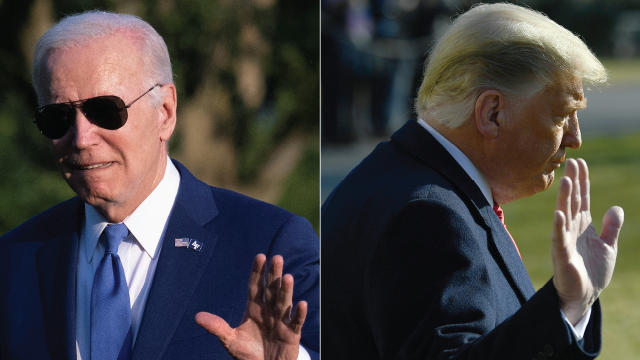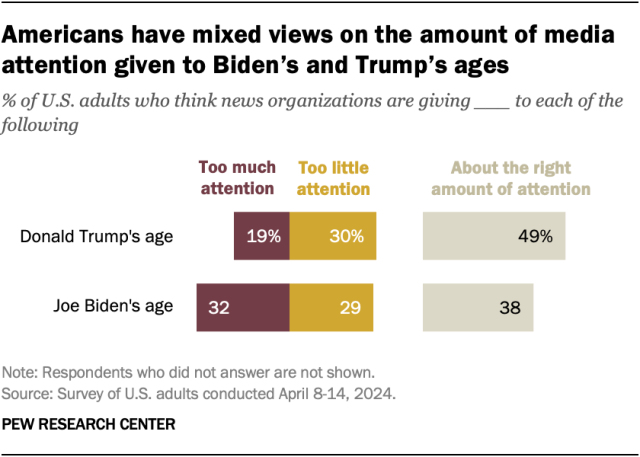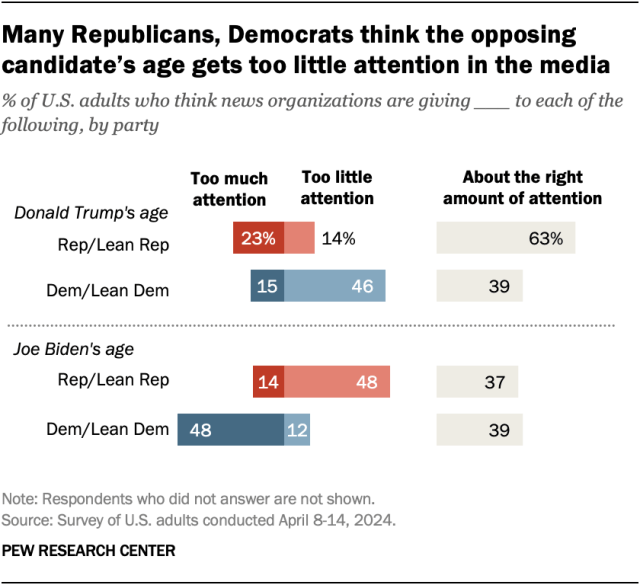
At age 81, Joe Biden is already the oldest president in American history. But former President Donald Trump, who will turn 78 in June, will become the oldest person ever elected president – surpassing Biden – if he wins back the White House this year.
It’s no surprise, then, that the ages of the candidates have been a major topic of conversation in news coverage of the 2024 presidential election. A new Pew Research Center survey finds that Americans have mixed feelings about the way news organizations are handling the issue for each candidate, with views sharply divided by political party.
To examine Americans’ perceptions of news coverage of the 2024 U.S. presidential candidates, Pew Research Center surveyed 8,709 U.S. adults from April 8 to April 14, 2024.
Everyone who completed the survey is a member of the Center’s American Trends Panel (ATP), an online survey panel that is recruited through national, random sampling of residential addresses. This way nearly all U.S. adults have a chance of selection. The survey is weighted to be representative of the U.S. adult population by gender, race, ethnicity, partisan affiliation, education and other categories. Read more about the ATP’s methodology.
Here are the questions used for this analysis, along with responses, and the survey methodology.
Pew Research Center is a subsidiary of The Pew Charitable Trusts, its primary funder. This is the latest analysis in Pew Research Center’s ongoing investigation of the state of news, information and journalism in the digital age, a research program funded by The Pew Charitable Trusts, with generous support from the John S. and James L. Knight Foundation.

Overall, similar shares of U.S. adults believe news organizations are giving too much attention (32%) or too little attention (29%) to Biden’s age. An additional 38% think the media cover Biden’s age about the right amount.
By comparison, Americans are less likely to say the news media are overemphasizing Trump’s age (19%) and more likely to think that news organizations give it about the right amount of attention (49%).
The same survey found that a larger share of American voters express confidence that Trump has the physical and mental fitness needed to be president than say the same about Biden.
Americans’ opinions on news coverage are split along party lines. Each party’s supporters tend to say that the opposing candidate’s age is getting too little attention.

Nearly half of Democrats and Democratic-leaning independents (46%) say news organizations are giving Trump’s age too little attention, compared with just 14% of Republicans and GOP leaners.
The numbers are virtually flipped when it comes to Biden: 48% of Republicans say Biden’s age is getting too little attention, while only 12% of Democrats say the same.
When it comes to coverage of their own party’s candidate, patterns within each party differ. While 48% of Democrats say that Biden’s age is getting too much attention, far fewer Republicans (23%) hold this view about Trump. Instead, most Republicans (63%) say Trump’s age is getting about the right amount of attention.
Any differences between older and younger Americans are much smaller than the gaps between partisans. Among Americans ages 65 and older, for example, 34% say news organizations give Biden’s age too little attention. That compares with 29% of those ages 50 to 64, 27% of those ages 30 to 49 and 26% of adults under 30.
Note: Here are the questions used for this analysis, along with responses, and the survey methodology. Senior Researcher Kirsten Eddy and Research Assistant Emily Tomasik contributed to this analysis.

